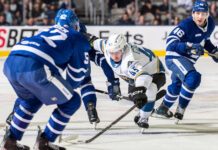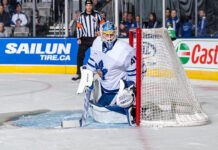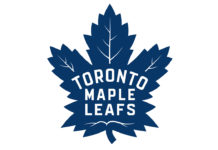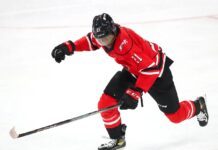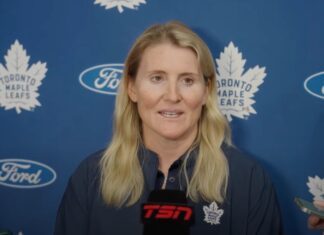As the trade deadline approaches with one eye towards summer free agency, the Toronto Maple Leafs are reportedly close on a contract extension for Jake Muzzin.
Last week, Darren Dreger reported, “They are working on some different scenarios, I would say. The expectation is that Jake Muzzin will be extended by the deadline.”
Pierre LeBrun followed up by noting that he believes the contract could come in at around four years and $5.5 million per season.
That contractual term would take Muzzin through to his age-35 season (he turns 31 this Friday, February 21).
At this point in time, Muzzin still remains a reasonably productive player who is playing to a 28-point pace with little power-play time. At 5v5, he’s the primary shutdown defenseman on the team. Alongside Holl, they have been holding their own: Their goal differential is even at 5v5, they are above water in shot share and scoring chance share, and their PDO is below average. It is a legitimate matchup pairing at this time.
Muzzin himself is playing nearly 22 minutes night. He is third on the team in even-strength time on ice per game and second in shorthanded time on ice per game. Despite a history of reasonable production and a good shot, he receives little power-play time (not even 13 minutes total so far on the season), and yet he finds ways to contribute offensively.
All in all, Muzzin is a legitimately solid top-four defenseman, but he’s aging. History has not been kind to the slower, shutdown-type defenseman as he ages into his 30s — especially now when a defenseman in that role needs the required footspeed to keep up with all the elite forwards in the league.
Muzzin is already tied for the 48th-oldest blueliner in the NHL (he and Ian Cole actually share the same birthday). Of the players ahead of him, there are a few examples of slower defensemen who have struggled in their mid-30s – Marc Staal, Matt Niskanen (who has started to trend down), Justin Braun, Brent Seabrook, and so on. There are also a number of players that have enjoyed more longevity, be it Mark Giordano, Kris Letang, or Jeff Petry.
Would Muzzin still be worth the $5.5M price tag next season? Likely yes. Would he be worth that money by year four? The betting money says no.
The problem is this, though: How is the Leafs‘ defense going to lose Muzzin and get any better? Morgan Rielly, Justin Holl, Rasmus Sandin, and Timothy Liljegren all appear primed to be on the team next season. One of them has fared well against good players: Justin Holl.
Rasmus Sandin has shown flashes, but he’s not there yet — the team doesn’t trust him with heavy minutes, nor should they. They barely trust Timothy Liljegren with any minutes at all. While both should become good players, hope is not a plan — especially not for a team that is trying to win a Cup right now, not three seasons from now.
The jury is still out on Travis Dermott, who is a pending restricted free agent.
Signing Muzzin leaves the team with three defensemen it can reasonably project as part of the core moving forward. The rest would be all question marks. Signing him also blocks off the left side — between he and Rielly — from Sandin or Dermott having any chance of moving up.
In an ideal world, Muzzin is signed to a three-year deal that would only take him through one year of Sandin’s and Liljegren’s second contracts. The odds of Muzzin signing for three years is slim to none, though. Four years is, at best, a starting point. If it gets up to five years, it shouldn’t even be a conversation. They can’t sign him to that.
The free-agent forecast actually isn’t terrible for defensemen this offseason, but it is pricey. Alex Pietrangelo headlines the class, and he would, of course, cost an arm and a leg. There are then a number of interesting options that would likely be expensive (and the Leafs need defensemen that can play defense, not Torey Krug). There is Chris Tanev, Travis Hamonic, TJ Brodie, Marco Scandella, and Sami Vatanen, to name a few. All have their warts, and it would be tough to argue any are clearly better options than Muzzin.
Ideally, Muzzin comes in cheaper than projected, but the truth is that he was underpaid on his past contract and that is probably a factor for him. Anything over that $5.5 million and it becomes dicey, but at that price point, it’s at least understandable why the Leafs would sign it. In a perfect world, the team isn’t in a situation where it feels its hands are tied — and perhaps the Leafs aren’t — but unless they are willing to part with a top-line forward to acquire a defenseman, signing Muzzin at least keeps their defense moving forward for next season and probably the one after that. It’s the two “out” years that are worrisome.
Notes
– Some interesting numbers when William Nylander and John Tavares play together: At 5v5, they have a 59 CF%, although that’s been achieved with a 61% offensive zone faceoff percentage. They have been on for three more goals against than they’ve scored (19 vs. 22). In part, that is due to the .840 save percentage they’ve been on the ice for (they are owning roughly 60% of the scoring chances). That said, they are two players that can get caught deep in the offensive zone as they both like to do their work down low. If the Matthews line isn’t matching up against top lines, it’s tough to trust this line in the role. If it’s neither line, the Leafs don’t have the type of bottom-six forward lines to really trust those defensively, either. It’s perhaps a reason why Keefe tried mixing up the lines, as he has used the Tavares unit as a bit more of a checking line.
– William Nylander is rebounding with a strong offensive season that was somewhat predictable given how he never got on track after missing training camp last year. I thought two things were extremely encouraging on the Muzzin goal against Ottawa Saturday. The first was how he created space for teammates to get open while holding the puck as well as how his teammates moved off the puck. At times last season, he would make similar plays holding the puck, teammates would stand around and watch him, and it would result in a giveaway. His ability to hold the puck is an asset, but only if his teammates do their part to move off of the puck and create lanes.
The second part is how he went to the net. If you watch the play, he passed the puck, took a hit, and actually battled his way to the net. That meant two extra bodies for the goalie to look through. The puck got through and into the back of the net. That’s just great work. Nylander didn’t pick up a point on the play.
– Nylander rebounding after a season where he missed training camp and struggled is reason enough for me to prefer not to move on from Travis Dermott. I’ve said it a few times that he hasn’t even played 150 games yet. That said, he can do without the complaining to refs – he got frustrated against Buffalo after a hook wasn’t called leading up to a goal, and then took a penalty shortly after. You have to remember that he’s still only 23, though. He has played over 20 minutes in four straight games now and they need him with the injuries back there. It’s worth noting that Tyson Barrie isn’t exactly the partner you would draw up for Dermott, too. It’s just been a difficult season for him, but he’s still very young.
– It seems like John Tavares has received some criticism this year, but the season he is having is a bit tough to describe. He is nearly a point-per-game player (51 points in 53 games) and scoring nearly every other game (23 goals) while missing time to injury and playing with a revolving door of linemates. Can you imagine if Tavares was centering Nylander and Marner, and Matthews was the one playing between Kerfoot and Hyman? He has also appeared to be playing injured (he could be seen leaving the bench at times). To top it all off, he is getting the toughest matchups while being asked to check and score. It’s a lot to ask — and also why he is so good.
It’s still a lot, and Tavares hasn’t exactly under-produced on the whole. This time a year ago, it would have been almost crazy to suggest taking Marner off of his line, but they haven’t played together for most of this season and Tavares remains productive. It’s easy sometimes to overlook what Tavares brings on an everyday basis — he’s not that flashy — but he does a lot of things right that help a team win hockey games.
– It is splitting hairs because the money ultimately isn’t much, but I found the timing on the Pierre Engvall contract curious. He very clearly entered the league on a bit of a heater and has come back down to earth. He has two points in his last 16 games. They have tried him at center, but he really looks to be a winger. If his production normalizes to that of a 20-point player who is a fourth left winger that can penalty kill, it is valuable, but $1.25 million per is a bit steep for a team that is tight against the cap. You can find penalty killers for less. If his play perks back up offensively, he is worth the money. Engvall turns 24 in May. It’s a fine deal overall, but it could have waited for the summer to see how his production and play ultimately shook out for the season, as he was going nowhere unless the Leafs wanted him to.
Quotes
“I mean, this is the worst we have been in a very long time. We haven’t been able to get the results that we are capable of getting, but it seems like each game has been a little bit different in terms of what the issues are. We just looked like we had tired legs all of the ice. We were second to pucks. As a result, we spent way too much time in our own end and we let their skill just kind of pick us apart.”
-Sheldon Keefe’s frustrations after a rather uninspiring loss to Buffalo
What I found most interesting here is the, “it seems like each game has been a little bit different,” part. It’s hard to point to just one or two things with this team right now, which is concerning. When the issues are clear, it’s easier to attempt to address them, but there seems to be a number of them right now, including how fragile this group still appears to be. I think they have enough to get into the playoffs as Florida continues to struggle, but it’s hard to see them being much more than first-round fodder if this continues.
“That’s when we got the momentum back on our side. That’s something we’ve missed here the last couple years. He’s made an impact … a guy that plays with an edge and plays physical and you saw that tonight, he got us going.”
– Auston Matthews on the Kyle Clifford vs. Jamie Oleksiak fight firing up the team
I know this quote got a lot of attention — and it did appear to inject some life into the team — so I don’t want to downplay it completely, but changing the lines looked to have just as much of an impact if not more. The Nylander – Matthews – Marner experiment hasn’t been completely terrible on its own, but the impact goes beyond that. John Tavares then has to play with second/third line tweeners and there’s only one line to really worry about if you’re the opponent — and it’s a line with a ton of holes defensively. Splitting up the lines helped turn the momentum as much as anything.
“Muzz is the man. He’s such a leader and brings it every night and I was so upset when we traded him in L.A. No offence to L.A. or anything, but I just missed him. It’s great to be back with him. He just adds a
great element to this really solid team.”– Jack Campbell on Jake Muzzin
This made me laugh, so I thought it was worth sharing for that reason alone, but you can see clearly through quotes from the players throughout the season how respected Muzzin is. He’s a valuable player and presence overall who brings a lot of things that this team lacks on the whole. I don’t know if it is a coincidence, but as the Leafs have added some more physical players of late (Clifford, Marchment, etc.), the physicality in his game has seemed to ratchet up a bit. He’s laid a number of strong hits over the past week and change.
Tweets of the Week
Since the Leafs made a coaching change they have the 4th highest pts% in the NHL. Unfortunately, #1 is Tampa and #3 is Boston.
— draglikepull (@draglikepull) February 16, 2020
One thing I’ve started to wonder about: Every decade, there are a few teams that are simply caught behind other elite teams and they often struggle to get over the hump — early 2010s Washington vs. Pittsburgh, Trotz’s Predators vs. Detroit and Chicago, and San Jose vs. LA, etc. The Leafs are a pretty strong team, but Boston and Tampa are the elite of the elite. Facing the possibility of playing them back-to-back in the first two rounds before getting to a potential Washington or Pittsburgh matchup is just ridiculous to fathom. It makes it extremely difficult to justify aggressively buying at the deadline.
I don't like talking about officiating, so here's a graph. pic.twitter.com/EGnCYFEOo4
— Ian Tulloch📊 (@IanGraph) February 17, 2020
At points, the officiating definitely has been brutal (what team wouldn’t say that? Ask Montreal from the weekend), but what I always go back to is this: I don’t often watch them play and think the refs are missing a ton of calls. The team just doesn’t seem to draw very much. If you want to talk about winning at the margins, acquiring some players that have proven they can draw penalties would be a huge benefit to this team given the strength of their power play.
With tonight's goal, Jack Eichel (.824 G/GP vs. Toronto) surpassed Alex Ovechkin (.820) to become the active leader in goals per game against the Maple Leafs (min. 5 GP).
— Sabres PR (@SabresPR) February 17, 2020
I have to give it to Jack Eichel in that he takes the Leafs and Matthews matchup personally. It shows. Every season, he seems to have a game or two where he completely lights them up. Since well before Eichel, though, Buffalo has been a house of horrors for the Leafs.
5 Things I Think I’d Do
1. I think the Nylander – Matthews – Marner line is an October or November experiment at this point. It is February, you’re in a playoff race, and your depth is affected by the Andreas Johnsson and Ilya Mikheyev injuries. I also don’t understand the timing in that the Tavares – Nylander combo and the Hyman – Matthews – Marner line were cruising along. Let them be. If you’re going to break up the lines, if anything, it should be to spread them out amongst the top nine because their depth is seriously hurting.
2. I think I would be moving Alex Kerfoot back to center the third line with Kasperi Kapanen. He isn’t bringing anything of consequence to the Tavares line that another guy couldn’t (say, Pierre Engvall), and the third line is struggling. Jason Spezza has exceeded my expectations by a mile, but he’s not a full-time top-nine center at this point in his career.
3. I know I wanted to see him up a number of times, but I think Mason Marchment hasn’t shown much to suggest he’s an NHL player at this point. He’s big and has been productive in the AHL, but he still looks too thin and awkward on his skates. Players with a low center of gravity (basically everyone in the league) can easily knock him off balance and win battles against him. He isn’t skilled or fast enough to make up for it. I’m glad we’re getting a look at him and I wouldn’t give up on him, but the early results are not promising. Egor Korshkov, on the other hand, looks like a player to me. He has some skill to go with that size. Calling up Kenny Agostino, who was a passable NHLer last year, also makes sense.
4. I think the Leafs should try to avoid pairing these young players up together and spread out their players with experience a bit better. The Timothy Liljegren – Rasmus Sandin pairing actually hasn’t been terrible when you look at the numbers — while they’re sheltered, they’re above the 50% mark in shot share, and they’ve only given up one goal more than they’ve been on for. But they get caught out for long cycles as they did versus Buffalo. The same goes for Korshkov and Marchment playing together in Buffalo on Sunday. The options are limited, but they can mix this up better.
5. At the present time, I think it’s hard to see how the Leafs make a move of consequence, and I wouldn’t blame Kyle Dubas for making only minor moves. They don’t have their first this year, they already traded more picks for Jack Campbell and Kyle Clifford, and there isn’t much in the way of prospects they can move unless they want to trade Liljegren or Sandin (and they don’t). Andreas Johnsson was probably a notable trade chip, but now he’s injured long term. They can’t move him and it probably makes the prospects of trading Alex Kerfoot or Kasperi Kapanen even less likely due to the reduced depth. The Ilya Mikheyev injury hurts them in this regard, too. It’s hard to envision them making a move where they swap players off their current roster and notably improve. If they want to trade for the future, that’s a bit of a different story.












